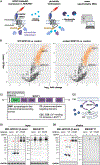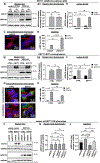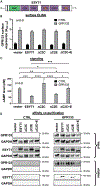Modulation of GPR133 (ADGRD1) signaling by its intracellular interaction partner extended synaptotagmin 1
- PMID: 38758649
- PMCID: PMC11209873
- DOI: 10.1016/j.celrep.2024.114229
Modulation of GPR133 (ADGRD1) signaling by its intracellular interaction partner extended synaptotagmin 1
Abstract
GPR133 (ADGRD1) is an adhesion G-protein-coupled receptor that signals through Gαs/cyclic AMP (cAMP) and is required for the growth of glioblastoma (GBM), an aggressive brain malignancy. The regulation of GPR133 signaling is incompletely understood. Here, we use proximity biotinylation proteomics to identify ESYT1, a Ca2+-dependent mediator of endoplasmic reticulum-plasma membrane bridge formation, as an intracellular interactor of GPR133. ESYT1 knockdown or knockout increases GPR133 signaling, while its overexpression has the opposite effect, without altering GPR133 levels in the plasma membrane. The GPR133-ESYT1 interaction requires the Ca2+-sensing C2C domain of ESYT1. Thapsigargin-mediated increases in cytosolic Ca2+ relieve signaling-suppressive effects of ESYT1 by promoting ESYT1-GPR133 dissociation. ESYT1 knockdown or knockout in GBM slows tumor growth, suggesting tumorigenic functions of ESYT1. Our findings demonstrate a mechanism for the modulation of GPR133 signaling by increased cytosolic Ca2+, which reduces the signaling-suppressive interaction between GPR133 and ESYT1 to raise cAMP levels.
Keywords: CP: Cancer; CP: Cell biology; ESYT1; GPR133; adhesion G-protein-coupled receptor; cAMP; calcium; extended synaptotagmin; proximity biotinylation proteomics.
Copyright © 2024 The Author(s). Published by Elsevier Inc. All rights reserved.
Conflict of interest statement
Declaration of interests D.G.P. and NYU Grossman School of Medicine own an EU and Hong Kong patent titled “Method for treating high-grade gliomas” on the use of GPR133 as a treatment target in glioma. D.G.P. and collaborators at NYU Grossman School of Medicine have filed a patent application titled “Anti-CD97 antibodies and antibody-drug conjugates”. D.G.P. has received consultant fees from Tocagen, Synaptive Medical, Monteris, Robeaute, Advantis, and Servier Pharmaceuticals.
Figures






Update of
-
Modulation of GPR133 (ADGRD1) Signaling by its Intracellular Interaction Partner Extended Synaptotagmin 1 (ESYT1).bioRxiv [Preprint]. 2023 Feb 9:2023.02.09.527921. doi: 10.1101/2023.02.09.527921. bioRxiv. 2023. Update in: Cell Rep. 2024 May 28;43(5):114229. doi: 10.1016/j.celrep.2024.114229. PMID: 36798364 Free PMC article. Updated. Preprint.
References
MeSH terms
Substances
Grants and funding
LinkOut - more resources
Full Text Sources
Molecular Biology Databases
Miscellaneous

